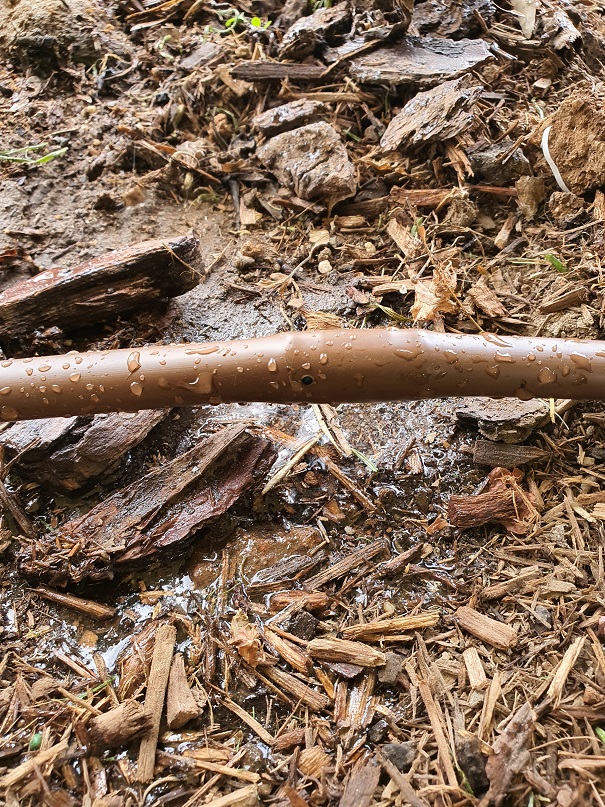
25 Aug A Practical Guide To Drip Irrigation
With summer only a few months away and the possibility we are heading into another drought, having a working irrigation system in your garden might be just what you and your garden will need. The most water efficient method of watering garden beds is to use a drip system. Covering this drip line with a fine grade mulch will also help prevent the moisture from evaporating.
The Bucket Test
Before you install drip line (or retic as it is called in Western Australia) you need to work out what the flow rate of your tap water is (if you are using water from a tank please also take note of information below). To test the flow rate you can complete the bucket test. Using a 9 litre bucket turn the tap you want to use for your irrigation on full blast and then time to see how long it takes to fill up the bucket. For example if it takes 30 seconds to fill up a 9 litre bucket then you have a flow rate of 18 litres per minute or 1080 litres per hour. Knowing this flow rate will allow you to know if you can supply enough water to run a drip system over a certain distance. If you don’t have enough water to run the drip system it will then allow you to make a decision on splitting the system over different taps or stations.
Measuring
Draw a rough outline of your garden beds then mark it up with some overall measurements. On this plan roughly draw where you want the irrigation line to be located. The lines of the drip line will need to be spaced out so that they sit approximately 400 -500mm apart from each other. The reason for this is that if you run your system for an ideal amount of time, the water will slowly seep into the areas in between. This is also as long as the soil is an organic, well draining mix. If you have hedges, then I would recommend running a line of drip line down each side of the hedge. If you have single shrubs, I would recommend that you run the line right around the base of the plant in a 360 circle. If you have a wide area of planting then lay out the line in a grid pattern so that it will run parallel to each other at approximately 40 – 60 cm apart. Avoid looping irrigation lines through beds as this can cause the lines to kink, some plants will receive more water than others. The main result of completing this measure is to work out how many linear metres of drip line you will need to reach every plant.
Types of drip line
We have all seen the large rolls of 13mm brown tube at the hardware store. This tube has a drip hole every 300mm. There are different types of drip line although they all look the same. We try to use the pressure compensating drip line (check the tag on the roll). This means that each drip on the line will deliver the same amount of water to each plant regardless of changes in pressure (changes in pressure can happen easily with other taps being used on the property, issues with council mains, changes in levels or pumps) throughout the drip irrigation system. A non pressure compensating dripper will not compensate for the pressure change, and thus not all your plants will receive the same amount of water.
Each dripper found on the line emits 2 litres of water per hour. The holes are located every 30cm. This will allow you to do a quick calculation. If you want to install 200 metres of drip line you will have 666 holes on this line. This means with 666 holes emitting 2 litres of water per hour you will need 1350 litres of water per hour to supply your irrigation system. If the system was only run for 30 minutes you would need 675 litres of water per hour. Having this measurement allows you to decide if one tap or more is needed for your system. This will allow you to design your irrigation layout. It will also tell you how many metres of drip line you can use before you lose water flow rate and the system losses its efficiency.
A general guide, (allowing for friction loss) if you wanted to install 200 metres of drip line, your tap water flow will need to able to fill a 9 litre bucket in 18 seconds.

Parts and Fittings
The brown dripline is widely available in a 13mm diameter. This will mean you need to use all 13mm fittings. Wherever possible as mentioned above the lines should be installed parallel to each other in straight lengths. It is much better to use 13mm tees and 13mm elbows with 13mm clamps to join the lines at right angles rather than winding the line around plants. Make sure you use steel pegs to keep the line in place.
Do I need a second tap?
Yes, it is always best to install an irrigation system onto a tap that is not needed for use of a hose. You can do this by installing a dual tap head that allows you to attach both a hose and an irrigation system, although don’t expect to use both at once. If you are installing a number of different lines then using solenoid valves throughout the garden may be your best option
Do I need a pressure reducer?
Most household taps and even those on tanks are going to have a pressure rating over 20 psi/137 kPa. Most drip lines are constructed to take 10 to 30 psi which is a low pressure. If your water pressure is greater than this then the fittings may blow out, become distorted and not work at their full capacity.
We would normally recommend a pressure reducer to be installed to try and reduce the wear and tear on the system.
If you are installing just a drip system then you probably don’t need to get the water pressure measured to give you the kPa/ psi. If you are going to install a pop up irrigation system then you would need to know this exact pressure measure. Installing pop up systems is a more specialised tasks that really needs to be completed by professionals.
Timers and Controllers
Adding an automatic timer to your system will allow the system to come on at set times so you don’t need to worry about when to water or leaving the system running for too long. The battery operated systems can be purchased from hardware or irrigation stores. These will attach to the tap. There are also timers that are available that have Wi-Fi and blue tooth capabilities. Depending on your location you can choose the one that suits you and your system best. If it is a large system, you could look at having separate stations for each area. This is a more specialised task and is well worth employing an irrigation specialist to complete.
Running Watering Systems from a tank
Ideally the tank will have a pump on it – the strength of the pump will determine the pressure and the flow rate. The size of the tank, the source of where the water is coming and the time it takes to refill the tank will determine how much water you can use in your irrigation system.
Gravity fed tanks can be used although the reliability of the pressure and flow rate may not be a constant. Trying to use battery operated irrigation timers on gravity fed tanks can also be problematic.
Running irrigation from Bore water or Dam water
Water that has high level of minerals or salts can over time block the lines. Ideally you will need to use a filter on the system to attempt to remove any debris, toxins and contaminants. In these situations having a settling tank or some form of filter before the water gets into the drip line will be required to ensure the system works at its highest capacity. I would also suggest installing flush valves throughout the system so that you can connect a hose to the line and flush out from time to time.

Extra Notes
– Always have your water tested first prior to using on plants if it is coming from a bore or creek.
-Be sure to check any local regulations on watering etc before using your system
-Here in Australia we do tend to work out pressure measures in kPa not psi however many of the fittings you buy, as they come from America or Britain will be graded in PSI measurements. To measure either you need a pressure gauge. This is a tool that irrigation specialists will carry.
– When in doubt use a qualified irrigation specialist. Irrigation systems need to be reliable and they can be costly so ensuring the system works to its full capacity is essential



